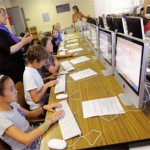 Khan Academy has been one of the more well known exponents of social learning, and in the last few years they have been teaming up with an increasing number of schools to test whether their particular brand of teaching maths and science delivers better results. As an educational experiment, it is one that has profound implications, not just on how children learn, but also adults and professionals.
Khan Academy has been one of the more well known exponents of social learning, and in the last few years they have been teaming up with an increasing number of schools to test whether their particular brand of teaching maths and science delivers better results. As an educational experiment, it is one that has profound implications, not just on how children learn, but also adults and professionals.
Earlier this year Khan Academy released a report outlining the findings from a two year study conducted by them into the success of the educational videos in 20 K-12 schools. The report reveals a number of interesting findings regarding how both teachers and students are utilizing the material on Khan Academy.
Whilst the usage of tools such as Khan Academy is still very much in its infancy, the report revealed a number of interesting findings. Perhaps most important of all is that 71% of students said they enjoyed using Khan Academy, with 32% revealing that using the videos made them enjoy maths more than previously.
This was reflected in very high engagement figures for students using Khan. 87% of students reported being either moderately or highly engaged, with nearly 1/2 students saying that the videos helped them learn things independently of specific teaching assistance. This independence was largely achievable due to the instant feedback students would receive on their work.
Interestingly, in light of suggestions that Khan might be used to flip the classroom, few of the schools were asking that students access the videos outside of school time. Extra-curricular usage ranged from a low of a few minutes per week to a high of 25 minutes per week.
Also of note however is the high level of support for Khan Academy amongst teachers. 86% would recommend using the videos to other teachers, with 89% planning to use them again next year. This is reflected in the finding that 85% of teachers believe using the videos had a strong or somewhat positive impact on student learning.
Usage of the Khan videos provided particular assistance with opportunities to practice new concepts, whilst also providing teachers with a good way of measuring progress amongst students. This allowed teachers both to provide remedial actions to those that are struggling, and also to set more advanced students work befitting their knowledge.
The biggest challenges were the lack of alignment of Khan Academy content to grade-level curriculum, lack of sufficient organization, and inefficient use of data reporting systems.
The report highlights a number of areas that may be of interest to those looking at learning in a professional context. Of particular interest is the popularity of Khan videos in providing a tailored and modular approach to learning that gives each individual their own unique learning pathway.